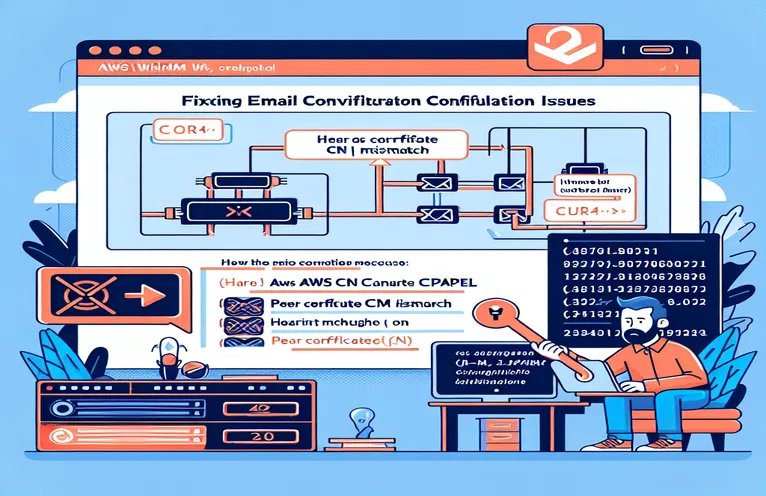Overcoming Email Configuration Challenges in Laravel on AWS
Email functionality is a critical component of most modern applications, and Laravel simplifies its integration with robust tools like SMTP. However, unexpected errors can throw a wrench in the works, especially when hosting on AWS WHM cPanel.
Imagine this: you’ve meticulously set up your Laravel application to send emails using Gmail SMTP. Everything seems perfect in your `.env` file. Yet, when testing the setup, you encounter a cryptic error involving a peer certificate CN mismatch. 😵
This exact scenario happened to me while using AWS’s shared hosting with WHM cPanel. Despite having all the correct configurations, emails simply refused to send. It was as if I had all the puzzle pieces but couldn't complete the picture.
In this guide, we’ll walk through why this error occurs and how to resolve it step-by-step. Whether you’re facing this issue for the first time or troubleshooting a similar one, let’s tackle it together to ensure your Laravel app sends emails like a charm. ✉️
| Command | Example of Use |
|---|---|
| stream_context_create() | Creates a stream context, allowing configuration of SSL options like verify_peer, verify_peer_name, and allow_self_signed for SMTP connections. |
| Config::set() | Used in Laravel to dynamically override mail configuration, such as SMTP stream settings during runtime. |
| Mail::fake() | A Laravel testing method that intercepts mail to simulate sending, enabling assertions without actual email delivery. |
| Mail::assertSent() | Verifies if a specific mailable was sent during testing, ensuring the email logic functions as intended. |
| setStreamContext() | Sets a custom stream context for email communication, useful for modifying SSL/TLS behavior in Laravel mailers. |
| AUTH LOGIN | A command used in SMTP to initiate authentication, typically requiring base64-encoded credentials. |
| EHLO | SMTP command sent to identify the sending domain to the email server, establishing the start of a session. |
| MAIL::alwaysFrom() | Sets a default sender email address globally for all outgoing mail in a Laravel application. |
| Mail::raw() | Used to send plain text email messages in Laravel without creating a Mailable class, simplifying quick tests or simple messages. |
| base64_encode() | Encodes a string in base64, often used for SMTP authentication by encoding usernames and passwords. |
Understanding and Solving Laravel Email Configuration Errors
When dealing with email configuration issues in Laravel, especially on shared hosting environments like AWS WHM cPanel, errors like the "peer certificate CN mismatch" can seem daunting. The first script above utilizes stream_context_create() to bypass certificate verification issues by creating a custom stream context. This method is useful when the mail server's SSL certificate does not perfectly align with expected domains, such as Gmail SMTP. Imagine you’re troubleshooting at 2 AM and realize the root cause lies in mismatched certificates; this approach provides a practical workaround. 🌐
The second solution leverages Laravel’s Config::set() method to dynamically adjust the mailer’s configuration at runtime. This is particularly helpful in applications that need flexibility when switching between multiple environments or mail servers. By overriding the default configurations with tailored settings, developers can resolve issues without modifying the core configuration files. Picture deploying a fix on a live site where immediate action is required, and this method becomes your go-to lifesaver. 💡
Testing is a vital part of ensuring email functionality. The third script demonstrates how to use Laravel’s Mail::fake() and Mail::assertSent() methods for unit testing. These tools simulate email sending, allowing developers to verify that their application’s email logic is functioning without actually sending emails. It’s like testing a parachute in a wind tunnel before a real jump—critical for building confidence that everything works as expected. These methods ensure your email setup is robust and reliable in various scenarios.
Finally, the Telnet-based troubleshooting example is a manual approach to diagnosing server-side SMTP issues. It demonstrates how to test connectivity to Gmail SMTP servers, authenticate with base64-encoded credentials, and manually send emails via command-line instructions. This method is often employed by server administrators to pinpoint specific points of failure in the email delivery chain. For example, while working on a corporate project, you might find this tool invaluable to confirm that firewalls or port restrictions aren’t blocking outgoing mail.
Resolving Laravel Email Configuration Errors with Modular PHP Scripts
Using PHP with Laravel's built-in SMTP functionality for secure and optimized email delivery.
// Solution 1: Fixing CN Mismatch Using Stream Context Options$mailConfig = ['ssl' => ['verify_peer' => false,'verify_peer_name' => false,'allow_self_signed' => true,]];$streamContext = stream_context_create(['ssl' => $mailConfig['ssl']]);Mail::alwaysFrom('finderspage11@gmail.com');Mail::send([], [], function ($message) use ($streamContext) {$message->setBody('This is a test email.', 'text/html');$message->addPart('This is the text part.', 'text/plain');$message->setStreamContext($streamContext);});// Test this in your Laravel controller or console to ensure proper functionality.
Leveraging Laravel's Config to Overcome Common Certificate Issues
Using Laravel's configuration override to manage mail settings dynamically.
// Solution 2: Dynamically Adjust Mailer Configurationuse Illuminate\Support\Facades\Config;// Set custom mail config in runtimeConfig::set('mail.mailers.smtp.stream', ['ssl' => ['verify_peer' => false,'verify_peer_name' => false,'allow_self_signed' => true,]]);// Trigger emailMail::raw('This is a test email.', function ($message) {$message->to('recipient@example.com')->subject('Test Email');});// Place this in your testing method or route controller for validation.
Testing the Mail Configuration with Unit Tests
Implementing unit tests in Laravel to validate mail delivery across multiple environments.
// Solution 3: Laravel Unit Test for Mail Functionalitynamespace Tests\Feature;use Illuminate\Support\Facades\Mail;use Tests\TestCase;class EmailTest extends TestCase{public function testEmailSending(){Mail::fake();// Trigger an emailMail::to('test@example.com')->send(new TestMail());// Assert that it was sentMail::assertSent(TestMail::class, function ($mail) {return $mail->hasTo('test@example.com');});}}
Alternative Approach Using Command-Line Tools
Testing SMTP connectivity directly using Telnet for debugging server-side issues.
// Open terminal on your server and test SMTP connection manually$ telnet smtp.gmail.com 587// After connection, verify EHLO commandEHLO yourdomain.com// Authenticate with base64 encoded username and passwordAUTH LOGIN// Enter base64 encoded usernamedXNlcm5hbWU=// Enter base64 encoded passwordcGFzc3dvcmQ=// Test sending a mail directly via SMTP commandsMAIL FROM: <your_email@example.com>
Ensuring Secure Email Configuration for Laravel Applications
One often overlooked aspect of email configuration in Laravel is the role of TLS encryption in maintaining secure connections. The MAIL_ENCRYPTION setting is crucial for protecting sensitive data such as login credentials and email content. When using Gmail’s SMTP server, ensuring the encryption method matches its requirements is critical. For instance, setting MAIL_ENCRYPTION=tls ensures that emails are transmitted securely over port 587, reducing the risk of data breaches. This small detail can make a big difference in protecting user trust and system integrity.
Another important consideration is the DNS configuration of your hosting environment. If your domain's SPF, DKIM, or DMARC records are not properly configured, Gmail’s servers might reject or flag your emails as spam. Adding these records to your domain's DNS settings improves your email deliverability. I once encountered this issue while setting up a newsletter for a startup; fixing the DNS records led to an immediate boost in open rates. It’s a reminder that technical missteps can sometimes have visible effects on user engagement. 📧
Lastly, Laravel's error logs are invaluable for diagnosing email issues. Enabling MAIL_DEBUG=true in your `.env` file can provide insights into failures during the SMTP handshake or authentication process. Reviewing these logs can uncover specific errors like certificate mismatches or connectivity issues, allowing for precise fixes. For instance, while troubleshooting a failed email campaign, I discovered through debugging logs that a firewall was blocking outbound connections. Fixing the firewall settings resolved the problem quickly. 🔍
Common Questions About Laravel Email Configuration
- How can I fix the certificate mismatch error?
- You can use stream_context_create() with relaxed SSL settings like allow_self_signed and verify_peer=false.
- What does the MAIL_ENCRYPTION setting do?
- It specifies the encryption protocol (e.g., TLS or SSL) used for secure communication between your application and the mail server.
- Why are my emails marked as spam?
- Check your DNS records for proper SPF, DKIM, and DMARC settings to improve email authenticity.
- Can I test email sending without actually sending an email?
- Yes, use Laravel's Mail::fake() method to simulate email sending in tests.
- What does the MAIL_DEBUG=true setting do?
- It enables detailed logging of SMTP communications, helping to identify errors in the email sending process.
Solving Laravel Email Configuration Challenges
Laravel email configuration issues can seem overwhelming, but with the right tools and adjustments, they are solvable. Focusing on SSL settings, DNS configurations, and utilizing debugging logs can address most problems. Real-world fixes, like bypassing mismatches, provide practical insights.
For long-term success, ensure that mail settings comply with security standards and hosting requirements. Effective problem-solving in such cases often leads to a deeper understanding of server configurations and enhances troubleshooting skills. With persistence, you can turn these challenges into learning experiences. 💡
Resources and References for Troubleshooting Laravel Email Issues
- Detailed Laravel email configuration documentation provided by Laravel Official Documentation .
- Insights into SSL/TLS certificate issues and fixes from PHP.net Documentation .
- Guidance on DNS configuration for SPF, DKIM, and DMARC records from Cloudflare DNS Learning Center .
- SMTP server troubleshooting tips shared on Stack Overflow Community Threads .
- Best practices for secure mail server setup provided by Google Support for Gmail SMTP .


